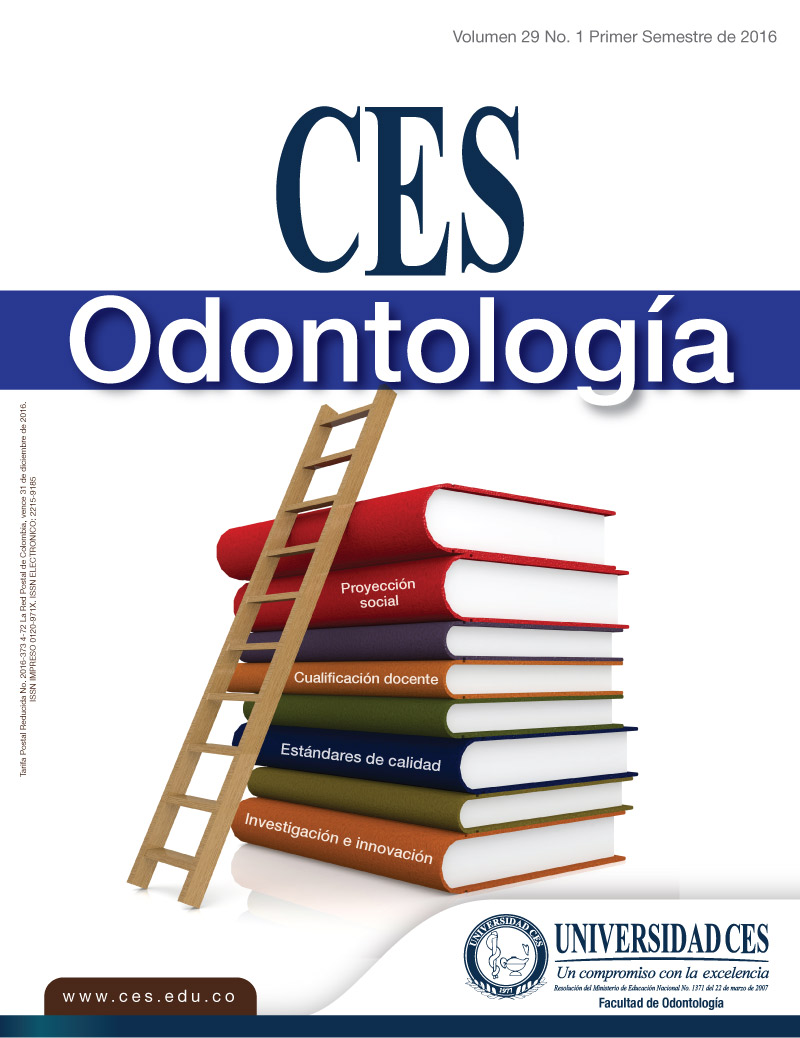Resistencia a la fractura de postes de fibra de vidrio vs postes colados en dientes anteriores. Revisión sistemática(Fracture Resistance of fiberglass post vs cast post in anterior teeth. Systematic review)
Resumen
Los dientes anteriores con tratamiento endodóntico y con pérdida de estructuradental usualmente son restaurados con postes de fibra de vidrioo con postes colados, y son susceptibles a presentar fallas que puedenllegar a ocasionar la pérdida dental por no ser rehabilitables. Se proponeaquí, identificar cuál entre los dos tipos de postes: prefabricados defibra de vidrio o postes colados, es más resistente a la fractura debido alas fuerzas biomecánicas compresivas o tensionales que se suceden enlos dientes anteriores rehabilitados con coronas respecto a la fractura delposte, de la raíz o el desalojo de este. Se realizó una revisión sistemáticade la literatura, con información recolectada desde las bases de datos delos buscadores: PubMed, Scielo, Lilacs y Science Direct. 93 artículos sobreel tema fueron tamizados según los criterios de selección. 4 cumplieroncon este procedimiento y se encontró que la resistencia a la fractura tiendea ser mayor en dientes restaurados con postes colados, pero cuando serepresenta es desfavorable para e. En el caso de los postes de fibra de vidriose presenta mejor resistencia a la fractura y presentan un patrón porlo general más favorable para un retratamiento en caso de éste fracaso
Abstract:
Anterior teeth with endodontic treatment and loss of tooth structureare usually restored with glass fiber posts or cast cores, which aresusceptible to present failures that may potentially cause tooth lossbecause they are not able to be restored again. It is proposed hereto identify which of the two types of posts: prefabricated fiberglass orcast posts, is more resistant to fracture due to biomechanical forcesof compression that occur in the anterior teeth restored with crownsrespect to fracture post , root or eviction of this. A systematic review of the literature was conducted with information gathered from the databasesof search engines: PubMed, Scielo, Lilacs and Science Direct. 93 articles on thetopic were screened according to the selection criteria. 4 met with this procedureand found that fracture resistance tends to be grater in teeth restored with castposts, but when a tracture accors is untaorubale for a restorative retreat. In thecase of fiberglass posts and greater remaining height structure better fractureresistance is presented, and they present a pattern usually more favorable forretreatment in case of fracture.
Descargas
Referencias bibliográficas
Ray A, Muse VV, Boyer DF. Case 38-2013: A 30-Year-Old Man with Fever and Lymphadenopathy. N Engl J Med. 2013; 369(24): 2333-43 https://www.ncbi.nlm.nih.gov/pubmed/24328468
Ruaro B, Sulli A, Alessandri E, Fraternali- Orcioni G, Cutolo M. Kikuchi-Fujimoto’s disease associated with systemic lupus erythematous: difficult case report and literature review. Lupus 2014; 23: 939–44. https://www.ncbi.nlm.nih.gov/pubmed/24739458
Dumas G , Prendki V, Haroche J, Amoura Z, Cacoub P, Galicier L et al. Kikuchi-Fujimoto disease retrospective study of 91 cases and review of the literature. Medicine (Baltimore). 2014; 93(24):372-82. https://www.ncbi.nlm.nih.gov/pubmed/25500707
Diez – Morrondo C, Pantoja-Zarza L, Manjón –Haces JA. Kikuchi Fujimoto's disease appearing as systemic lupus erythematosus. Reumatol Clin. 2012; 8(3):153–55. https://www.ncbi.nlm.nih.gov/pmc/articles/PMC4935008/
Weiss LM, O'Malley D. Benign lymphadenopathies. Modern Pathology 2013; 26: S88-S96. http://www.nature.com/modpathol/journal/v26/n1s/full/modpathol2012176a.html
Cramer J, Schmiedel S, Alegre NG, Schafer H, Burchard GD, Merz H. Necrotizing lymphadenitis: Kikuchi–Fujimoto disease alias lupus lymphadenitis?. Lupus (2010); 19:89–92. https://www.ncbi.nlm.nih.gov/pubmed/19933723
Gionanlis L ,Katsounaros M , Bamihas G, Fragidis S, Veneti P, Sombolos K . Kikuchi-Fujimoto disease and Systemic Lupus Erythematosus: The EBV connection? Renal Failure. 2009; (31)2:144–8. https://www.ncbi.nlm.nih.gov/pubmed/19212912
Kim SK, Kang SM, Yoon BY, Kim DY, Cho SK. Histiocytic necrotizing lymphadenitis in the context of systemic lupus erythematosus (SLE): Is histiocytic necrotizing lymphadenitis in SLE associated with skin lesions? Lupus. 2011; 20 (8): 809–19. https://www.ncbi.nlm.nih.gov/pubmed/21562017
Lamzaf, L, Harmouche H, Maamar M, Adnaoui M, Aouni M, Tazi Mezalek Z. Kikuchi-Fujimoto disease: Report of 4 cases and review of the literature. European Annals of Otorhinolaryngology, Head and Neck diseases. 2014; 131 (6):329–32. https://www.ncbi.nlm.nih.gov/pubmed/25294358
Baltaci M, Fritsch P. Histologic features of cutaneous lupus erythematosus. Autoimmunity Reviews. 2009; 8(6):467–73. https://www.ncbi.nlm.nih.gov/pubmed/19162243
Xavier, RG, Silva DR , Keiserman MW, Lopes MF . Kikuchi-Fujimoto disease. J Bras Pneumol. 2008; 34(12):1074-78.
K Sousa Ade A, Soares JM, Sá Santos MH, Martins MP, Salles JM.ikuchi-Fujimoto disease: three case reports. Sao Paulo Med J. 2010; 128 (4): 232-5. https://www.ncbi.nlm.nih.gov/pubmed/21120436
Tariq H, Gaduputi V, Rafiq A, Shenoy R.The enigmatic Kikuchi-Fujimoto disease: a case report and review. Case Reports in Hematology. 2014; 2014, 648136. https://www.hindawi.com/journals/crihem/2014/648136/
Akinbami A, Odesanya M, Soyemi S, John-Olabode S, Adediran A, Oshinaike O et al . The Kikuchi-Fujimoto disease in Nigeria: a case report and literature review. Case Reports in Medicine. 2014; 2014:171029. https://www.ncbi.nlm.nih.gov/pmc/articles/PMC4020498/
Aota N, Hirahara K, Kano Y, Fukuoka T, Yamada A, Shiohara T Systemic Lupus Erythematosus presenting with Kikuchi-Fujimoto’s disease as a long-term sequela of drug-induced hypersensitivity syndrome. Dermatology. 2009; 218(3):275-7. https://www.ncbi.nlm.nih.gov/pubmed/19088463
Sharma V, Rankin R. Fatal Kikuchi-like lymphadenitis associated with connective tissue disease: a report of two cases and review of the literature. Sharma and Rankin Springer Plus. 2015; 4:167. https://springerplus.springeropen.com/articles/10.1186/s40064-015-0925-7
Descargas
Publicado
Cómo citar
Número
Sección
| Estadísticas de artículo | |
|---|---|
| Vistas de resúmenes | |
| Vistas de PDF | |
| Descargas de PDF | |
| Vistas de HTML | |
| Otras vistas | |



